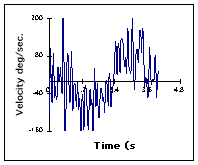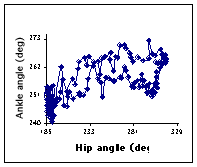RESULTS: Angular Kinematics
Segment angle. Though the motion of the two movements is similar, the motion of the trunk segment varies between a squat with heavy weight and one with lightweight. As you can see by comparing the two graphs, the trunk segment motion corresponding to the graph on left has greater rotation. Here, we see a range from 0 degrees all the way up to approximately 75 degrees in the clockwise direction. The graph on the right has a slightly smaller range of motion. This motion segment started at an angle of 12 degrees and peaked at 55 degrees. This motion was again in the clockwise direction. After peak angle was reached, both motions followed counter-clockwise rotation back to their initial positions.
|
|
|
|
Figure 3. Trunk segment angle during the heavy squat (left) and the light squat (right). The trunk segment angle is calculated from the vertical axis about the hip joint. Anatomical position corresponds to an angle of zero. Increasing values represent clockwise rotation. The x-axis "time" is in seconds and the y-axis "angle" is in degrees. | |
Joint angle 1. The motions of the hip joint angle in both graphs were very similar. However there is a delay at the beginning of the extension phase in the graph at left. Both graphs showed peak angles around 320 degrees. The initial angles of the flexion phase of each movement varied just slightly. The hip angle in the graph at left started at an angle of 187 degrees and the hip angle in the graph at right started at 204 degrees with each hip joint returning to their initial angles at ceases ion of the movement.
|
|
|
|
Figure 4. Hip joint angle during the heavy squat (left) and the light squat (right). Hip joint angle is calculated as the angle between the trunk segment and the thigh segment. Anatomical position corresponds to an angle of 180 degrees. Increasing values represent flexion. The x axis "time" is in seconds and the y axis "angle' is in degrees. | |
Joint angle 2. The movements were similar in that they both had an ankle joint angle peak of approximately 273 degrees and they both began with an angle around 252 degrees. Despite these similarities, the graph on the left of the heavy squat depicted an initial counterclockwise motion about the ankle joint, while the right graph was shown to basically begin with a clockwise motion. A comparison that was made between the two graphs was that, in the graph on the left the motion about the ankle joint switched from counterclockwise motion to clockwise motion multiple times throughout the complete movement; while on the right graph the ankle started out in the clockwise motion and primarily only changed to the counterclockwise motion after reaching peak angle degree.
|
|
|
|
Figure 5. Ankle joint angle during the heavy squat (left) and the light squat (right). Ankle joint angle is calculated as the angle between the lower leg and the foot segment. Anatomical position corresponds to an angle of about 270 degrees. Increasing values represent dorsiflexion. The x-axis "time" is in seconds and the y-axis "angle" is measured in degrees. | |
Joint velocity. Knee joint angular velocity comparison between the two squat movements indicated similar patterns, but distinct magnitudes of movement. The graph at left showed peak extension velocity had reached 153 degrees per second, while the graph at right showed a peak extension velocity had reached 309 degrees per second. Also, flexion peak velocities were significantly different, as the movement in the left graph had only reached &endash;152 degrees per second compared to the movement in the graph at right, which had reached &endash;345 degrees per second.
|
|
|
|
Figure 6. Knee joint angular velocity in the heavy squat (left) and the light squat (right). Positive values represent flexor velocity. The x-axis "time" is in seconds and the y-axis "velocity" is measured in degrees per second. | |
Angle-Angle Plot. The angles of our two joints are coordinated in phase on both graphs. This can be seen because both graphs show a somewhat positive slope. This means that as the hip flexes in both movements, the ankle dorsiflexes. The graph on the right also shows us that for that movement, the segments are coordinated at the switching point. We see at the end of the graph, there is a curvature downward. This tells us that the joints reach their maxima at approximately the same time and switch from flexion/dorsiflexion to extension/plantarflexion. We also see that the graph on the right show the light squat has a greater range of motion.
|
|
|
|
Figure 7. Coordination of hip joint angle and ankle joint angle in the heavy squat (left) and light squat (right). The x-axis "hip angle" is measured in degrees and the y axis "ankle angle" is also measured in degrees. | |









